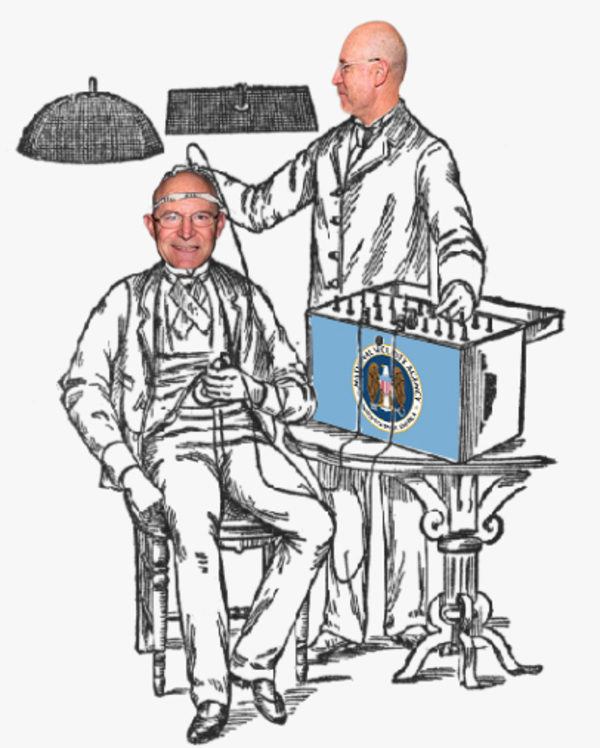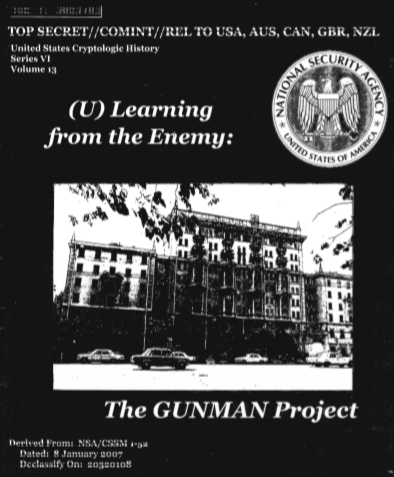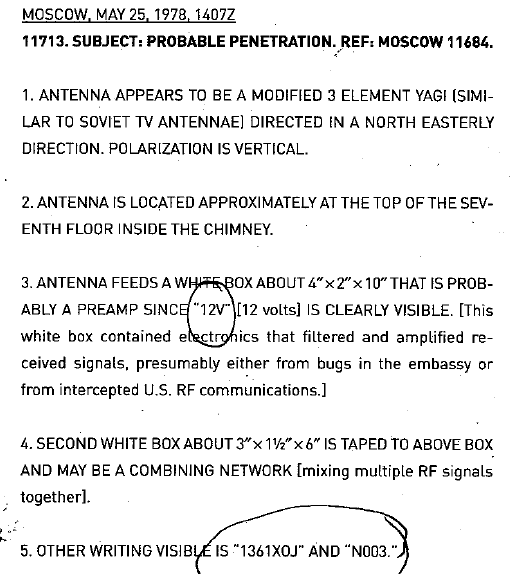The psycho-shock has already happened to the NSA chief and storyteller, Eric Haseltine (lead images), so he is paralysed by a Russian weapon that's about to psycho-shock the reader. That's you.
After you read this, you will never again be able to type on a keyboard without anticipating that the "diabolically clever" Russians are reading every word. But maybe you are suspicious the Central Intelligence Agency (CIA) might be doing the same thing? "Naw", says Michael Arneson, Haseltine's hero and NSA engineer from a dirt poor Minnesota family with no more than a high school diploma, and whose favourite drink is Mr Pibb. "The CIA is way too incompetent to create something this good." In this tale, American heroes fit to fight the Russians and save you from your keyboards, talk like that.
Haseltine, 68, has made a lifetime career out of inventing electronic warfare devices to fight someone. He has grown rich at it, too.
He began at the Hughes Aircraft Company which produces cruise missiles, satellites, radars, air surveillance and control systems. He then worked for Walt Disney Imagineering, the research branch of the entertainment group, which developed fiber-optics, audio and other special effects for mass deception. Electronically engineered by inventors like Haseltine, he holds dozens of patents himself for devices still too secret to explain. In 2002 he was recruited to become the head of the NSA's research directorate.
His recruiter then, and blurb-writer for the book today, is the US Air Force general and electronic warfare specialist, Michael Hayden, who was head of NSA when he engaged Haseltine. Hayden, 75, started his Air Force career in 1969 and keeps most of it, including operations in listening posts in Stuttgart, Guam, and South Korea, secret. Introducing Haseltine from the Disney group "with no intelligence experience", he omitted Haseltine's time at Hughes. It was there that the guidance, targeting, interception and jamming technology Haseltine was inventing was paid for and operated by Hayden's operational commands. They are still in dividend, royalty, and profit-sharing business together as "good friends and now enjoy serving on a corporate board together." The Chertoff Group, Motorola, and Caliburn are among the Russia war-fighting businesses which pay Hayden every month.
According to Hayden, he and Haseltine are among the handful of US patriots and heroes in the military services and intelligence agencies who wage the "interagency turf fights that give the Russians an added edge against us." If there wasn't that Russian edge, Hayden and Haseltine wouldn't have made their fortunes. For example of his evidence, Hayden writes "Russian efforts change the outcome of our 2016 presidential election come to mind." Haseltine repeats the line in his concluding chapter: "The 2016 election episode taught the Russians that when they get caught conducting active measures to de-stabilize America, America wouldn't do much to retaliate but would spend years tearing itself apart."
Never mind the past four years of every form of investigation imaginable to have established reasonable doubt about the evidence for this claim - not to mention the failure of all US court litigation to prove the case. Hayden, Haseltine, and their NSA heroes insist that the signals intelligence they say they detected can only mean their enemy, the Russians, originated it. To be sceptical, to suggest that the signals may have been manufactured by the NSA itself (a CIA and State Department view reported in passing in the book) is no more than "recriminations, finger pointing bitter political disputes" which are the most powerful of Russian weapons. "Going all the way back to Lenin," Hayden says at the start of Haseltine's tale, "dividing Russia's enemies has not just been a means to an end for the Kremlin but a desired end all unto itself."
Left to right: Vladimir Lenin; Charles Gandy, hero and principal source for Haseltine's story; read his record from his NSA Hall of Honour citation; Walt Deeley, Gandy's immediate superior at NSA, received his Hall of Honour citation in 2014. And Michael Arneson, their junior. Deeley received an NSA bounty of $50,000 for his part in the story; Gandy and Arneson $10,000 each. Arneson went on to privatize his NSA expertise and patents; in 2004 he resold them for $236 million.In this world of words and warfare signals, you are either on Lenin's side, or on the NSA's. There's almost no room for sex. Almost — but Haseltine wouldn't be selling a book called The Spy in Moscow Station if there weren't girls (Haseltine and his NSA men have traditional tastes).
Of course, the girls are on Lenin's side. "Standing before him", inside a top-secret section of the US Embassy Moscow, "was one of the most beautiful women he had ever seen. She wore a frilled, very low-cut Russian peasant blouse...Gandy's gaze involuntary [sic] wandered to the blouse which did a poor job of covering the woman's ample, braless breasts... 'Perhaps I could come in for a drink...You could help me practice my English'."
Haseltine's misspelling of "involuntarily" is one of two bits of signint from his brain which give his game away. The other signal is that the meaning of the word is false. Gandy was meant to fall for the honey-trap. Gandy's brain defied the improbability that such a girl could have penetrated security to reach his door and fired signals down to his crotch and other parts, all of which fired back that he should accept the invitation; for a nano-second or two his NSA jammer failed. He blamed Lenin for that, and also the KGB pimp he detected down the top-secret Embassy corridor where "he saw a large man in an ill-fitting suit, pressing his back to the wall."
The KGB wears ill-fitting suits - in this thriller you don't need to be an electronic surveillance expert to spot them. There are dozens of these giveaway signals which Haseltine makes visible to the naked eye; for example the "blackhatted [KGB] officer...wearing a menacing expression"; and the KGB clandestine surveillance agent who left "a neat ten-by-ten matrix of cigarette butts left at the stairway landing [inside the US Embassy]".
But there's also a smoking gun, detected with Gandy's naked eye. But that is so improbable it exposes Haseltine' story to be a fiction, which is exactly what the CIA and the State Department later said it was. For suspense, we'll come to that in a minute.
The plot is a forty year-old one, told to Haseltine by Gandy, about how he, Walt Deeley and Michael Arneson uncovered a network of electronic surveillance bugs concealed inside the US Embassy in Moscow, broadcasting from inside 16 of 250 IBM Selectric III typewriters at work in the US ambassador's office and other offices; collected, amplified and then relayed by an antenna to KGB listening stations outside the building. The ingenuity of the devices and their concealment was so great, Gandy told Arneson, who had discovered the typewriter implant, it had evaded all the US counter-intelligence detection technologies then in operation.
Defenceless and electronically blind, the US is the innocent victim throughout this story.
" 'Why didn't we see it on top of interposers?' Mike asked. 'Because the other side is diabolically clever [said Gandy]. With a tiny horseshoe magnet, you're never going to see any net lines of flux because, in the vertical orientation, with one pole on top of the other, the fields will appear to cancel each other. The only way to spot the magnets is to turn the interposers on their sides where you can see the magnetic field lines exiting and entering the poles."
Reader note: if interposers, magnets, flux and poles are as easy for you to decode as a girl's braless breasts exiting a Russian peasant's blouse, then this pole thrill will be rigidly convincing. Not to everyone, though. " 'I think that Gandy faked the whole thing'" a CIA analyst reported later, "to justify their wild claims and get bigger budgets." "'Gandy never proved a single thing he said,' reported a senior CIA officer. 'He was like a lot of technical men who raised alarms but in the end never had any proof'." A State Department assessment was that Gandy's discoveries were timed by the NSA to sabotage negotiations on strategic nuclear arms control between the Soviet Foreign Minister Andrei Gromyko and his Reagan Administration counterpart, George Shultz. The State Department also had a term for Gandy's discoveries of KGB bugs; he had "dry-labbed" them; that was to say, the NSA fabricated them.
"The Evil Empire might be eating our lunch", Deeley managed to slip into the Oval Office to tell President Ronald Reagan. Reagan liked the line and winked. "'Get on with it, but don't take forever'" was Deeley's decoding of the wink.
When Arneson and Gandy found what they were hoping for, "Mike's first comment upon seeing America's colours in the electrical wires inside a Soviet bug, was 'Ain't that sticking it right in our face? Maybe the fricking CIA did this just to fuck with NSA...Naw. CIA is way too incompetent to create something this good.'"
Just how good became apparent in assessments by the CIA, State and every other agency of the US Government with an interest in Project GUNMAN and the exposure and rollup of CIA assets in Moscow. They followed after Gandy, Deeley and Arneson had trousered $90,000 in personal payoffs; the 1981 sum is equivalent to $256,000 today - a genuine thrill.
The declassified original NSA report of Gandy's investigations, released in 1986, to which Haseltine has added honey-traps. He fails to mention this report, authored by Sharon Maneki, as a source. He does issue this disclaimer, revealing that his book has been vetted and authorized before publication: "No classified information was used in the book...Neither NSA nor CIA, who approved release of the material as unclassified, acknowledges the accuracy of any of the accounts."But Haseltine concedes at the end of the book the evidence that the NSA's bug discoveries had led to serious Soviet gains was "weak" and "circumstantial". So Haseltine tried a Disney trick - what a mouse would say if, hypothetically and suspending belief, he could talk.
"One final piece of evidence that indicates how much GUNMAN implants did to US national security was the very existence of the GUNMAN system itself....Russia was (and is) a poor country that was not in the habit of focusing scarce resources on unproductive pursuits... Bottom line: the Soviets believed the GUNMAN system was worth the investment over an eight-year period. Would they have felt this way if reading typewriters in the US Embassy didn't compromise US national security in meaningful way?"
Projecting NSA budgeting logic on to the KGB like this fails to convince anyone outside the NSA, Haseltine admits in his last line. "So, how much damage did the GUNMAN implants do," he asks the reader, "either on compromised arms negotiations or human intelligence gathering in Moscow?" He replies: "Either a little or a lot, depending upon whom you choose to believe."
This is the psycho-shock at the surprise ending. Evidence, smoking guns cannot be in doubt; choosing to believe, like believing in Russians as devils, is religious. According to Haseltine's evidence, the NSA is a church of devil-worshippers.
However, there is a smoking gun, and the surprise of it doesn't come at the finale. Here it is on page 64, the reproduction of a top-secret State Department cable by Jack Matlock, Deputy Chief of Mission in Moscow, reporting the NSA discovery of a signals antenna concealed in a chimney shaft inside the Moscow embassy building, pointed at the ambassador's office.
Gandy, Deeley, Arneson, General Hayden and President Reagan were all so confident that this was part of the GUNMAN system devised and operated by the KGB, undetected by the US, they failed to see exactly what Matlock reported - they were the inscribed voltage and serial codes on the apparatus, 12V, 1361XOJ and N003. In 1978, when the KGB allegedly invented these machines, the KGB used Cyrillic lettering, not English. It was thus impossible for the Russian manufacturer's codes to be written in the enemy's language. As visible to the naked eye as the girl's breasts popping out of her blouse were for Gandy in 1978, and as mesmerising for the NSA from then until now, these codes reveal an American fake.
There are more of them. "In both the 2016 hack of the Democratic National Committee (DNC) and the 2018 nerve agent attack in the UK," Haseltine winds up the reader at the very end, "Russia left subtle - or not-so-subtle - calling cards."
If after everything has been reported, examined, and tested of the DNC materials and of the Skripal case, Haseltine and his million-dollar patriots still believe this, then there can be no cure for their psycho-shock. As for you, dear reader, you are safe. You know that seeing isn't believing. Also, you've just been saved the $25 NSA wants you to spend to keep believing their deception.







Reader Comments